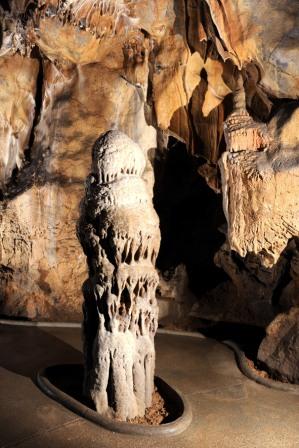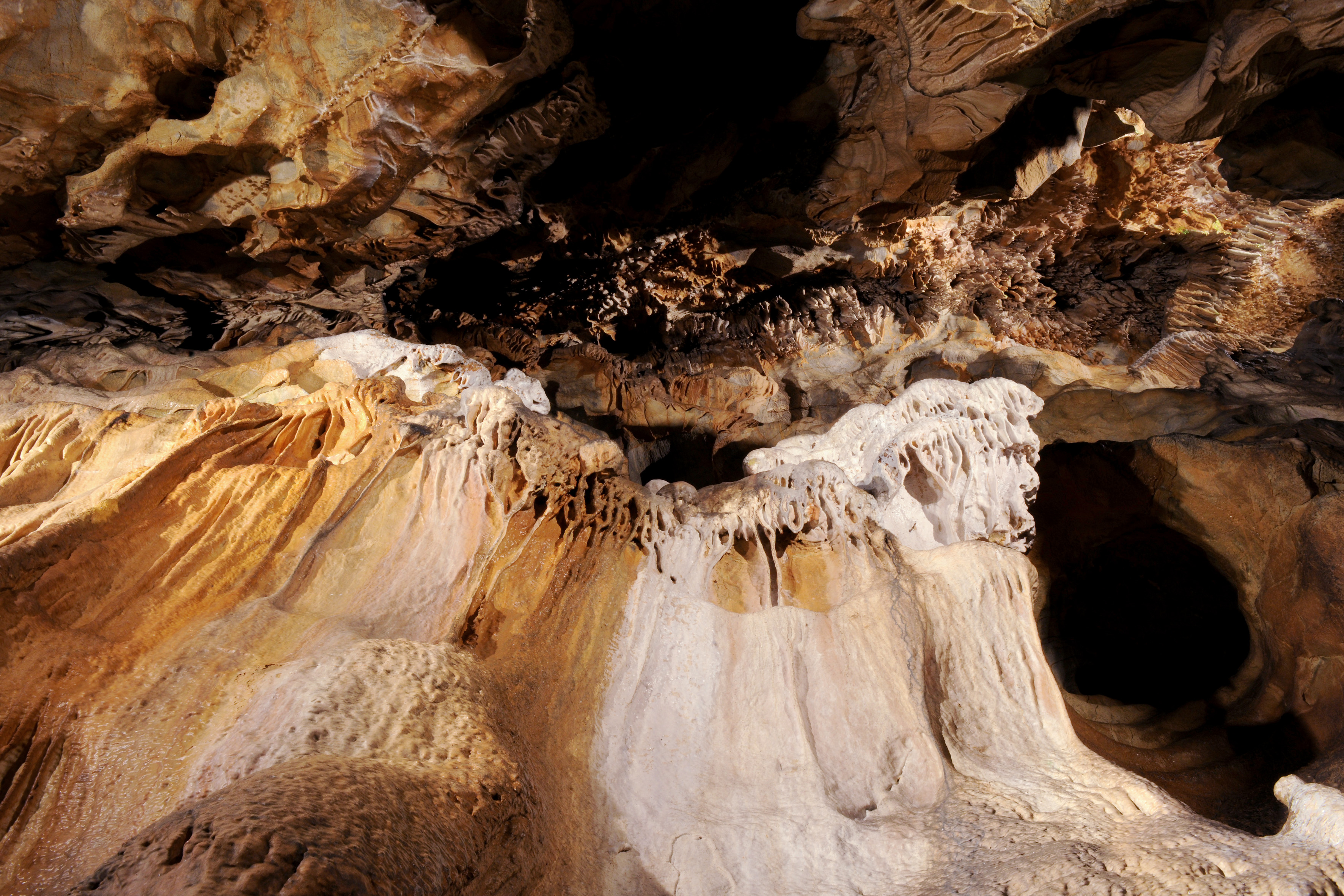Mladeč Caves - Natural conditions

GEOLOGY AND KARST
The islets of limestones in the Mladeč Karst belong geologically to one of the belts of Devonian rocks from the Central Moravian part of the Bohemian Massif called the Konice-Mladeč Devonian. This belt emerges in the SW – NE direction from the base of surrounding Early Carboniferous flysch rocks in the Bouzovská Highlands and crops out under the cover of Neogenous and Quaternary sediments in the rock bottom of the MoravaRiver valley on the Třesín Threshold and in the north-western part of the Uničov Plain. The Devonian belt and its wider surroundings is tectonically part of the Hornomoravský úval block – an old but very unstable tectonic unit of the Bohemian Massif. A very important system of old faults in the NW – SE direction, a part of the distinct Haná Fault Zone, crosses the area of the Třesín Threshold, which is divided not only geologically, but also morphologically.
The limestones of the Moravian Karst, which are equivalent to the Vilémovice limestones of the Macocha Formation, emerge from the Earth's surface in the Mladeč Karst. They are tabular, bedded to massive and during the Variscan folding they underwent weak metamorphosis. They are separated from the surrounding Culm rocks (predominantly greywackes) and also from the limestones of the Javoříčko Karst tectonically by a series of faults. The part of the Mladeč Karst on the Haná Fault Zone is covered with mighty gravel-sand infilling of the Morava River valley.
On limestone outcrops, especially on the morphologically most outstanding Třesín Hill, surface karst phenomena – lapies and limestone pavements, dolines, shallow depressions and grabens – are developed. In the Mladeč Karst, well-developed sand pipes uncovered e.g. in the Skalka quarry in Měrotín (Geological Organ Natural Monument) are found. Among underground karst phenomena, in addition to the Mladeč Caves another four caves are described:
The Knies Cave, 3 x 2 m with a steep chasm filled with clay sediments, was discovered in 1904 under the cliff about 50 m north of the entrance to the Mladeč Caves. A large number of human bones including skulls, bone and flint tools, and also many bones of Pleistocene animals was found here and used for research purposes. However, the cave was later destroyed by continued quarrying.
The Na Třesíně Cave 1 was situated under the cliff another 50 metres north and was also quarried away. No discoveries were made in this cave.
The Podkova Cave is a 162 m long arched corridor with two entrances. Originally two caves were artificially connected during the romantic landscaping at the beginning of the 19th century by request of landowners – the Liechtensteins. There were findings here of human bones and Pleistocene animals together with flint industries similar to discoveries from the Mladeč Caves. The first written mention of the cave dates back to 1670. The cave is inhabited by 12 species of bats and horseshoe bats, Barbastelle (Barbastella barbastellus) and the Greater Mouse-eared Bat (Myotis myotis) being among the most important.
The Třesín Cave (also the Ve štole Cave) is an 87 m long labyrinth of halls and their corridor junctions uncovered at the end of a 265 m long exploration gallery through which the supplies of limestone were checked in 1969. Adapted and partly expanded areas of the cave are used today as a speleotherapeutic sanatorium for children.

The Na Třesíně 2 Cave is a 14 m deep corrosion shaft cave situated in the slope of the ridge part of the Třesín Hill. The existence of other expected and so far uncovered cave systems was confirmed by hydrogeological investigation of the underground karst drainage. The cave is a part of an extensive karst aquifer flowing through deep in limestones from the village of Javoříčko to the Morava River valley, which feeds the spring area of Čerlinka, an important source of drinking water in the Olomouc region. Several ponors and active karst seepages in the Mladeč Karst, e.g. Řimice exsurgences under the north-eastern foot of Třesín Hill, are linked to it.
STALACTITE AND STALAGMITE DECORATION OF THE MLADEČ CAVES
Despite considerable devastation during the 19th century when it was expected that the caves would be destroyed by continued quarrying, relatively rich stalactite and stalagmite formations were preserved in some places of the cave. In the underground spaces with smoothly corroded walls, numerous rock coulisses and corrosive notches, which were mistaken by some explorers for the work of prehistoric man, stalactites, massive stalagmites, sinter crusts and colour sinter coatings were formed, preserved to this day, and are still being formed on the walls in some halls of the cave. Smaller stalactite and stalagmite formations, such as straw stalactites and carrot stalactites, were partly destroyed by people in the past. Even larger stalactite and stalagmite formations were removed from the first uncovered spaces and could be found on sale at the marketplace in Olomouc or they decorate graves at the Olomouc cemetery.
Only stubs of roots were left behind in the cave. Sinter crusts on the floor were, unusually, removed during archaeological excavations. Nevertheless, in the cave there are picturesque corners where, in addition to old stalactites and stalagmites, new decorations are also being formed. Chrám přírody (Temple of Nature) and Panenská jeskyně (Virgin Cave) belong among the most beautiful and also the best preserved ones. The underground system is dominated by a symbol – an over two-metre-high stalagmite called Mumie (Mummy).
